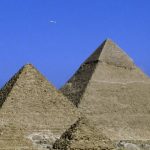Egypt tells Elon Musk its pyramids were not built by aliens0
- From Around the Web, UFO News
- August 5, 2020
Egypt has invited billionaire Elon Musk to visit the country and see for himself that its famous pyramids were not built by aliens.

Egypt has invited billionaire Elon Musk to visit the country and see for himself that its famous pyramids were not built by aliens.

Egypt says archaeologists have discovered a “massive” ancient building in the town of Mit Rahina, 20 kilometers, or 12 miles, south of Cairo.

Egypt says archaeologists have discovered a statue of a lion’s body and a human head in the southern city of Aswan.

A view looking north to south of Egypt’s famous Giza Pyramid Complex, as seen by ESA’s Proba-1 minisatellite.

The oldest known copy of a text claiming to be Jesus’ teachings to his brother James has been discovered in an ancient Egyptian trash dump, scattered among piles of fifth-century papyrus, ancient tax receipts and bills of sale for wagons and donkeys.

Archaeologists believe they have solved one of history’s most puzzling questions – how the ancient Egyptians transported over 170,000 tons of limestone to build the Great Pyramid at Giza.

I’ll say this off the top, I believe we don’t know our true history, not even close. What we’re going to explore in this article are mathematical mysteries about the Great Pyramid will challenge your perception of what we know of our past.

A quarter of a century ago, researchers Robert Schoch and Robert Bauval were at the centre of two controversial debates in Egyptology: Schoch, with his geological redating of the Great Sphinx to a period earlier than its supposed builder, the Pharaoh Khafre; and Bauval, with his ‘Orion Correlation Theory’ that suggested the three famous pyramids of Giza were laid out to mimic the stars in the ‘belt’ of the constellation Orion.

Analysis of Egyptian fossils has identified a new species of extinct carnivorous mammals called hyaenodonts, according to a study published April 19, 2017 in the open-access journal PLOS ONE by Matthew Borths from Ohio University, United States of America, and Erik Seiffert from University of Southern California, United States of America.

A team of archaeologists has uncovered a unique carved alabaster statue of Queen Tiye in Luxor, Egypt. The exciting find was made by the European-Egyptian mission that works under the wings of the German Archaeological Institute.



